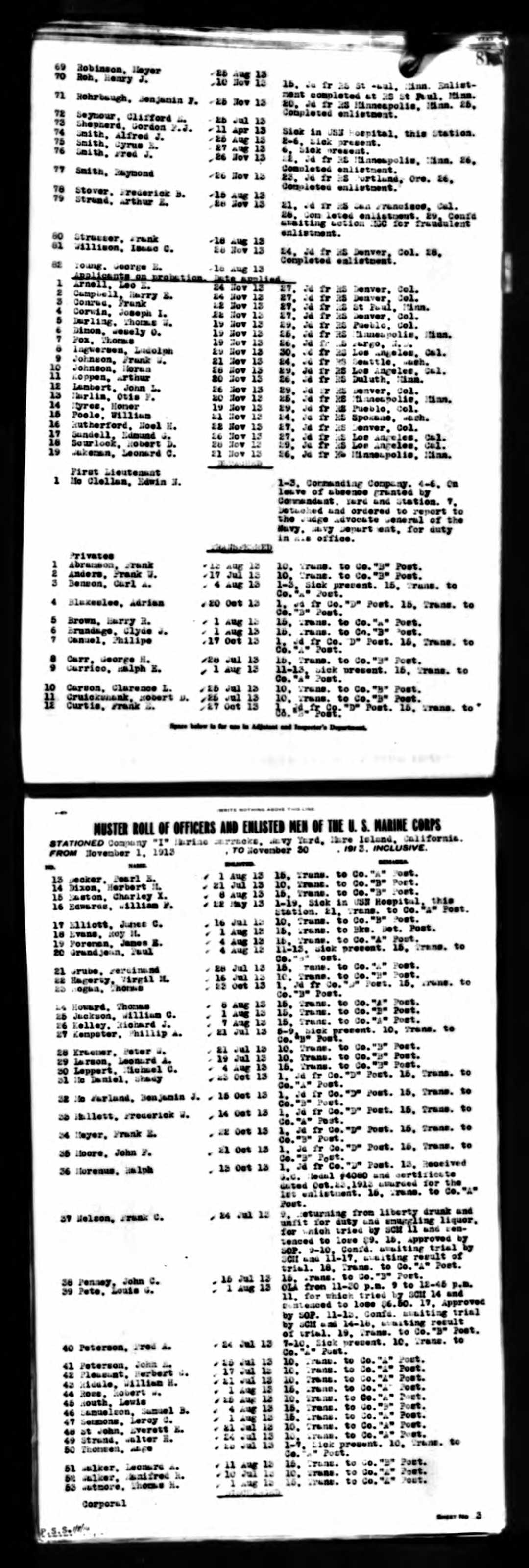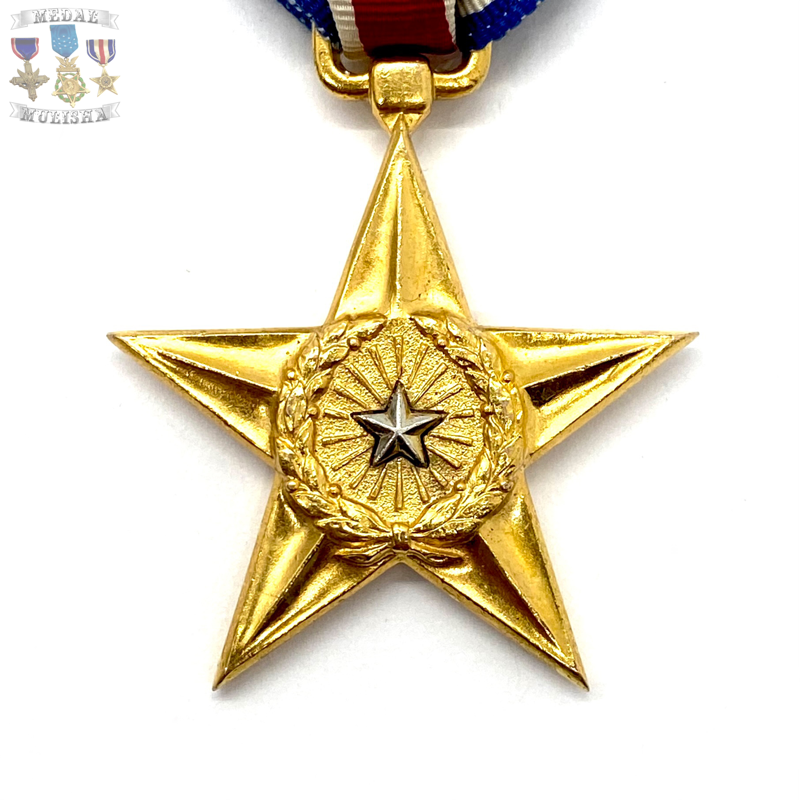1911-1917 MEXICO SERVICE & 1913-1917 GOOD CONDUCT MEDAL John L. Lambert Group
Marine Corps Good Conduct Medal No. 7689
John L. Lambert
John L. Lambert
1920's "BB&B" Marine Corps Mexico Service Medal #1909
John L. Lambert
John L. Lambert
Corporal John L. Lambert enlisted in the United States Marine Corps Dec. 4th 1913. From April 1914 to June 1914 Lambert was stationed on the U.S.S. South Dakota. In Nov. 1914 Lambert classified for a Marksman Badge. In April 1915 Lambert received the sharpshooter badge for the year of 1914. In Nov. 1915 Lambert Received the ER insignia. Records show Lambert on the U.S.S. Buffalo from Dec. 1915 to Jan. 1916. In June 1916 Lambert participated in engagements with Dominican rebels at Las Trincheras, Dominican Republic & a skirmish with Dominican rebels at Dona Antonia, D.R.
In July 1916 Lambert participated in engagements with Dominican rebels at Guayacanes, Dominican Republic & he participated in the occupation of Santiago, D.R.
Lambert became a Corporal in Jan. 1916 from the regimental Commander. Feb. 1916 Lambert received a letter of commendation from the Navy department relative to the assault and capture of Portalesa San Francisco de Macoris, Dominican Republic on Dec. 1st 1916, while serving with 29th Company, 4th Marine Regiment. Corporal Lambert was issued Good Conduct medal No. 7689 in 1917 after his first enlistment. He was also issued Mexican Campaign medal #1909.
In July 1916 Lambert participated in engagements with Dominican rebels at Guayacanes, Dominican Republic & he participated in the occupation of Santiago, D.R.
Lambert became a Corporal in Jan. 1916 from the regimental Commander. Feb. 1916 Lambert received a letter of commendation from the Navy department relative to the assault and capture of Portalesa San Francisco de Macoris, Dominican Republic on Dec. 1st 1916, while serving with 29th Company, 4th Marine Regiment. Corporal Lambert was issued Good Conduct medal No. 7689 in 1917 after his first enlistment. He was also issued Mexican Campaign medal #1909.
U.S.S. South Dakota
The first USS South Dakota (ACR-9/CA-9), also referred to "Armored Cruiser No. 9", and later renamed Huron, was a United States NavyPennsylvania-class armored cruiser.
South Dakota was laid down on 30 September 1902 by the Union Iron Works, San Francisco, California, she was launched on 21 July 1904; sponsored by Grace Herreid, daughter of Charles N. Herreid, Governor of South Dakota, and commissioned on 27 January 1908, Captain James T. Smith in command.
South Dakota was laid down on 30 September 1902 by the Union Iron Works, San Francisco, California, she was launched on 21 July 1904; sponsored by Grace Herreid, daughter of Charles N. Herreid, Governor of South Dakota, and commissioned on 27 January 1908, Captain James T. Smith in command.
U.S.S. Buffalo
The second USS Buffalo (later AD-8) was an auxiliary cruiser of the United States Navy, and later a destroyer tender.
Buffalo was launched on 31 May 1893 by Newport News Shipbuilding and Dry Dock Company, in Newport News, Virginia, as El Cid for the Southern Pacific Railroad's Morgan Line. She was completed in August 1893 and sold to Brazil and renamed Nichtheroy. Purchased by the Navy from the Brazilian Government on 11 July 1898, she was renamed Buffalo, commissioned in ordinary a week later, fitted out as an auxiliary cruiser at New York Navy Yard; and placed in full commission on 22 September 1898, with Lieutenant Commander Joseph Newton Hemphill in command.
1898–1915
Her first cruise, from 7 December 1898 to 7 May 1899, was from New York City to Manila and return, sailing east. Upon her return she was placed out of commission on 3 July 1899. On 2 April 1900, she was recommissioned and served as a training vessel. As a training vessel, Buffalo traveled widely. She made four voyages to the Philippines with replacement crews for the Asiatic Fleet (24 April – 20 October 1900, 24 December 1900 – 13 May 1901, 5 June – 13 October 1902, and 17 December 1903 – 14 July 1904). All except the last, which terminated at Mare Island, began and ended at east coast ports. On her last voyage, Buffalo conveyed the 1st Torpedo Flotilla to Manila. Between 12 September and 23 November 1904 she cruised in the Pacific, returning to Mare Island.
Out of commission at Mare Island from April 1905 to 17 November 1906, she then served as a transportuntil 1915 in the Pacific. During 17–20 December 1909, she carried Marines to Nicaragua and remained there in support until 16 March 1910. In 1911–12, she served briefly with the Asiatic Fleet in Chinese waters; and then from 14 November through 4 December 1914 operated off Mexico. She spent 27 January through 29 November 1915 out of commission at Mare Island, and then rejoined the Pacific Fleet.
Buffalo was launched on 31 May 1893 by Newport News Shipbuilding and Dry Dock Company, in Newport News, Virginia, as El Cid for the Southern Pacific Railroad's Morgan Line. She was completed in August 1893 and sold to Brazil and renamed Nichtheroy. Purchased by the Navy from the Brazilian Government on 11 July 1898, she was renamed Buffalo, commissioned in ordinary a week later, fitted out as an auxiliary cruiser at New York Navy Yard; and placed in full commission on 22 September 1898, with Lieutenant Commander Joseph Newton Hemphill in command.
1898–1915
Her first cruise, from 7 December 1898 to 7 May 1899, was from New York City to Manila and return, sailing east. Upon her return she was placed out of commission on 3 July 1899. On 2 April 1900, she was recommissioned and served as a training vessel. As a training vessel, Buffalo traveled widely. She made four voyages to the Philippines with replacement crews for the Asiatic Fleet (24 April – 20 October 1900, 24 December 1900 – 13 May 1901, 5 June – 13 October 1902, and 17 December 1903 – 14 July 1904). All except the last, which terminated at Mare Island, began and ended at east coast ports. On her last voyage, Buffalo conveyed the 1st Torpedo Flotilla to Manila. Between 12 September and 23 November 1904 she cruised in the Pacific, returning to Mare Island.
Out of commission at Mare Island from April 1905 to 17 November 1906, she then served as a transportuntil 1915 in the Pacific. During 17–20 December 1909, she carried Marines to Nicaragua and remained there in support until 16 March 1910. In 1911–12, she served briefly with the Asiatic Fleet in Chinese waters; and then from 14 November through 4 December 1914 operated off Mexico. She spent 27 January through 29 November 1915 out of commission at Mare Island, and then rejoined the Pacific Fleet.























